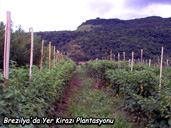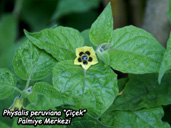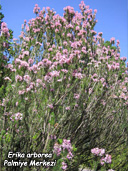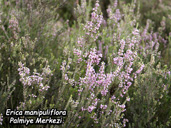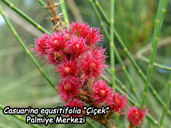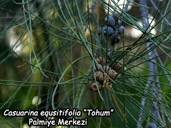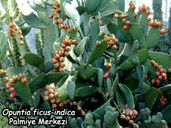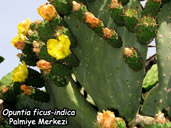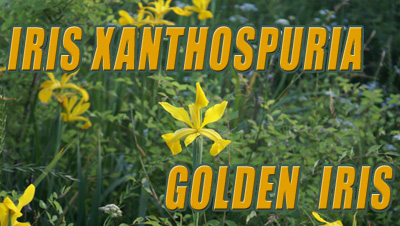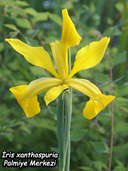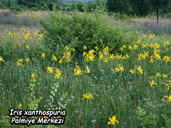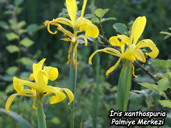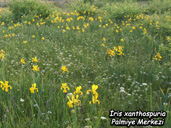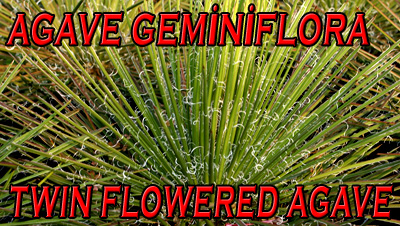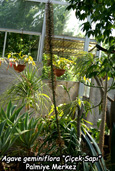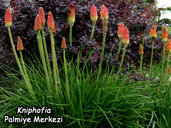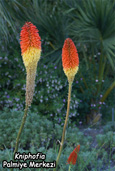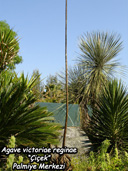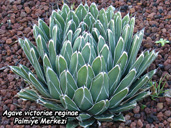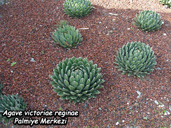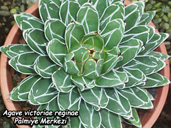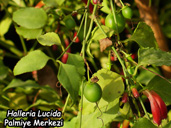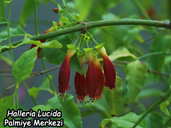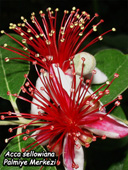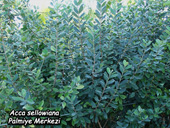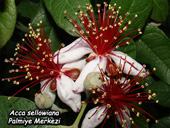 |
| |
|
|
|
If you wish this
program to be sent to your or your friends’ e-mail address,
please get a subscription (totally free of charge, and no
advertisements will be sent). I would like to get a subscription to “The Fourth Dimension in Landscape Design”>>>>>>> |
PEYZAJDA 4. BOYUT December 2009
|
|
PEYZAJDA 4. BOYUT November 2009
|
|
PEYZAJDA 4. BOYUT October 2009
|
|
PEYZAJDA 4. BOYUT September 2009
|
|
|
The pancratiums (sea daffodils) are members of the amaryllidaceae family. There are 16 types, all long-lived plants growing from bulbs. They are found near to the sea growing in sand or amongst rocks. They are widespread from the Canary Islands to West Africa, Namibia, the shores of the Mediterranean and tropical Asian countries. Leaves are produced in two layers and are long, thin, ribbon-like; the flowers have 6 petals. The sea daffodil Pancratium maritimum’s homeland is the shores of the Mediterranean, the western Black Sea and south-western Europe; unfortunately having survived for generations along the shores of the Black Sea in general, it is now dying out.The bulbs lie 20-30cm beneath the surface of the soil, which means they get water even in the summer. The leaves are long and thin and green with a hint of blue. Sometimes in the heat of the Mediterranean summer these leaves can disappear altogether. The flowers open between August and October on stems which are 30-40cm long. Flowers are creamy white with 6 petals and a pleasant scent which is most noticeable in the evenings. This plant can withstand salt and light frost. It grows best in damp soil. It is propagated from seed or division of bulbs. In the wild, even in places where it hasn’t died out naturally, it is endangered by coastal development and is becoming an increasingly rare plant. For this reason the Palm Centre has made a commitment to protect this plant by propagating more specimens, and has designated a small area of land exclusively for this purpose.
|
PEYZAJDA 4. BOYUT August 2009
|
|
PEYZAJDA 4. BOYUT July 2009
|
|
|
The Opuntias are the most widespread and well-known forms of cactusus (cacti). In the wild, in common with other cactusus, they are found in the western hemisphere, but from the 15th century onwards Europeans have been introducing them to other parts of the world. Opuntia gets its name from Ancient Greece, where other thorny plants were found in the region around the city of Lokris Opuntia. The genus Opuntia is to this day still expanding as new members are discovered. It is, however, generally agreed that all opuntias are cactus composed of flat, wide segments. This is the most widespread of all types of cactusus with 181 varieties occurring naturally in the wild, and a further 10 hybrid forms which have hybridised naturally. The best known form is Opuntia ficus-indica, with its Turkish name of Diken Inciri (Thorny Fig). In English it is called Prickly Pear or Indian Fig, but in Turkey it is the Thorny Fig (Diken Incir) or Pharaoh’s Fig (Firavun Inciri). It grows to the size of a shrub or even a tree and can reach a height of 6m. A mature plant will have a trunk of 30 – 40 cm wide. The segments which make up the trunk are grey-green or just green. The oval or elliptical segments vary and can be long, short, narrow or wide. On the edge of the wide segments, about 2 – 5cm apart, can be found areoles which are surrounded by yellow or brown glochids (short, barbed hairs), which soon fall off the plant. There will usually be 1 or two thorns adjacent to each glochid. Yellow flowers, bowl-shaped and 8 – 10cm in length open in spring. They are followed by pink fruit about 10cm in length covered in hairs which can cause itching. Nowadays this plant is grown all over the the world with many people benefiting from its fruit. It is especially popular in South Africa, Australia and the Mediterranean. The plant is the home of the cochineal beetle which gives a red dye and Opuntia ficus indica is grown on the Canary Islands purely to produce cochineal beetles. The fruit can be eaten straight from the plant or made into jams and marmalades. It has now become so widespread in South Africa that the thorny version is now a banned plant, although the thornless type can still be planted. There are currently moves in Australia to also ban further planting. |
PEYZAJDA 4. BOYUT June 2009
|
|
|
Today’s plant Golden Iris can very hardly be acquired anywhere in the world except at the Palm Centre. It grows naturally along the edges of Köyceğiz Lake, and is endemic to the area. Some sources claim that it can also be found in the Hatay region, but there has been no objective scientific verification of this claim. This valuable plant is sought by collectors all over the world. Iris xantospuria was first raised at the Palm Centre in 2008. We are going to sending specimens to botanic gardens who request them. We have also begun to sell Golden Iris at June 2009 at the Centre. Iris xanthospuria (in Turkish ‘Altın Süsen’) is a member of the Iris family, grows from rhizomes and is a very long-lived plant. Except when the weather is extremely cold, it is green at all times of the year with leaves between 30 and 80cm in length. In the wild it grows in swampy areas, but with sufficient watering it will thrive anywhere. It prefers wet ground and lots of sun.It is different from the Iris psudacorus-Yellow Iris (in Turkish ‘Sarı Süsen’) widely found in this country and often used in landscaping schemes in Europe, in that it does not have brown markings in the centre of its petals. Golden Iris has six spotless dark yellow petals, three which grow upright and three which curl outwards. Each flower has three stamens (male organs). Golden Iris can withstand cold, but as yet there has been no scientific study of to exactly what degree of frost it is hardy. It is propagated from seed or from splitting rhizomes from established plants. At the Centre we are currently undertaking studies of propagation and hardiness. |
PEYZAJDA 4. BOYUT May 2009
|
|
|
The agaves are a family of up to 250 varieties found in the wild in Mexico, USA and Central America. They all share thick leaves (succulent) and grow in the shape of a rosette. Most agaves are ‘monocarps’ which means they flower once and then die. We would like to introduce you to Agave geminiflora which is possibly the ‘softest’ of all the agaves. In general agaves with thin, elegant leaves are not frost hardy. However, Agave geminiflora will withstand frost down to -2 degrees centigrade for short periods. The species name geminiflora comes from the Latin for "twin flowered", and refers to the fact the flowers are grouped 2 per bracts, along the spike. It is found in the wild in the state of Nayarit in Mexico where it grows within oak forests at heights of 900 – 1200 metres. It will grow in shade but does like a lot of water. It is usually single-stemmed and when fully grown the diameter does not exceed 60–90cm. Mature specimens sometimes have a very short stem from which 100–200 leaves have grown. The leaves are long, thin and soft. They are narrow some 6-12mm wide and 40–60cm in length. Along the edges of the leaves can be found tiny filaments at even intervals. The leaves are dark green and easily bent. The lifespan of Agave geminiflora is not more than 8-10 years, after this the plant sends up a large spike that can be up to 5 metres tall. Agave geminiflora’s long, thin flower stem will normally grow to 250–350cm. The top two thirds of this stem will be covered with flowers, grouped in pairs. The flowers are yellow with a base of red or purple. Agave geminiflora var. Atricha Trelease is a variety with shorter leaves which are harder and without filaments. This plant will not exceed 25 – 35cm in diameter. Agave geminiflora is propagated from seed. It doesn’t produce offspring as do many other agaves, although it has been reported to do so when planted in crowded conditions. To grow it in frost-free areas plant in full sun. Where there is a danger of frost it can be planted in a pot where it will grow well, but will need constant watering. In landscape design Agave geminiflora is used for the effects of its symmetry and is a striking plant when used alone or in groups. Single specimens can be placed for contrast within colourful, flowering perennials or it can be planted in groups for a sculptural |
PEYZAJDA 4. BOYUT April 2009
|
|
|
Kniphofia is a genus of around 70 varieties found in the wild in the Tropics and South Africa, in mountains and particularly along river banks and in wetlands. Most of the varieties grow from rhizomes and spread. The flowers, held on tall stems, can be yellow, orange, red, white or any combination of these colours. In Turkish this plant is called the ‘Lighthouse Plant’ because of the shape and colours of its flower stems. As can be seen from the photographs, each flower head is actually made of many tiny pipe-shaped flowers. The flowers are attractive for bees. The leaves vary according to the variety and can be any length between 10cm and 100cm. The leaves of varieties which die back in winter tend to be thin and grass-like, whilst those which are evergreen have thicker leaves. The best known variety is Kniphofia uvaria. Nowadays many hybrids are available which can vary in overall height from 50 – 180cm. In landscaping the hybrids are preferred because they are more showy and sturdier. Some varieties cannot withstand frost, others will take light or medium frost. This plant is not too fussy about planting conditions, but it does very well indeed in well-drained, humus-rich soil with a light sand content. It will grow in full sun or partial shade. Propagation can be by seed planted in spring or by planting rhizomes split from an existing plant at the end of spring. In landscape design it is often used in groups which give a strong structural effect when all the plants are in bloom. Shorter hybrid forms can be used as ground cover whilst the taller varieties look good planted between trees. |
PEYZAJDA 4. BOYUT March 2009
|
|
|
The Agaves comprise some 250 species which are found in the wild in Mexico, the USA and Central America. All of them share the fact that they are succulents and their leaves grow in a rosette format. Many agaves are monocarpics which mean they flower once in their lives and die after flowering. Over 125 types of Agave can be found in Mexico and the one we are introducing you to here, Agave victoriae reginae, is generally held to be the most elegant. And the value of this plant does not just lie in its elegance; it is also a very slow grower. In general it is a solitary plant, growing with one stem, occasionally it may give off springs. Nowadays Agave victoriae reginae is one of many plants which are disappearing in Mexico and, for that reason, it is now under Government protection. The diameter of the plant normally will not be greater than 50cm, although there are occasional reports of specimens reaching 70cm. It has dark green leaves 4-5cm wide and 15-20cm long. The leaves are triangular in shape with white edges. The leaves form a rosette, a very pleasing shape. In general after the plant has reached 20 years of age, a long 3-4m flower stem grows up which produces many cream-coloured flowers with red-purple striped edges. After the flowers turn to fruit and then seed, the plant dies. The main need of Agave victoriae reginae is sunshine, it can manage without much water. In the winter it can withstand cold down to -120C for short periods. It is propagated from seed or by removing off springs. Variegated and compact forms are also available. In rock or cactus gardens it can be planted alone, in general it is used in groups. In cold places like Ankara it can be grown in a pot and brought indoors in the winter. |
PEYZAJDA 4. BOYUT February 2009
|
|
|
|
PEYZAJDA 4. BOYUT January 2009
|
|
|
The Acca are two species of plant that members of the Myritaceae family. The old name for ‘Acca’ was ‘Feijoa’ from the Brazilian botanist Silvio Feijo. These plants are found in the wild in Brazil, Argentina and Uruguay in sub-tropical regions, both species grow to a maximum of 4.5m in height and with a similar lateral spread. The Acca are grown for their general ‘look’, their attention-grabbing flowers and edible fruit. They are not at all fussy about soil. They may prefer well-draining soil, but equally they can be grown in acidic or alkaline soils, and in dry or wet soil conditions. However they do like a lot of light, and should be planted where they are guaranteed full sun.As for climate they prefer a hot place which does not get frost. In fact they will only fruit, and continue to fruit, in a frost-free environment. However, apart from the lack of fruit they can withstand light frost. They can be grown from seed planted in spring or semi-hardwood cuttings taken in summer. Pineapple Guava: In Turkey only one of the accas is known as Kaymak Ağacı or “Ananas Guava” (Pineapple Guava in English) with the Latin Acca sellowiana or old name Feijoa sellowiana. They are grown in some parts of Turkey. The ‘sellowiana’ comes from a German plant hunter Sellow who first discovered this plant in 1819. Another Turkish name is ‘Ananas Guava’ which translates as ‘.Cultivation of this plant in Turkey is confined to the Marmara and Black Sea regions and is not yet widespread. It is grown for fruit and as a single trunked tree with branches starting 1 – 1.5m above the ground. When growing commercially for fruit a space of 4-5m x 2-3m is left between trees. Thus a 1000 sq.m. will contain between 60 and 120 trees. The trees will start to give fruit from 3-4 years of age. It is believed that such trees have a life span of around 50 years. The Feijo is a hermaphroditic plant which means that its flowers contain both male and female organs and one tree will fruit. In commercial situations to prevent single trees producing too much fruit they may spread pollen from one tree to another. Fruits are green, about 5cm in length and oval. They should be picked and then left for a week or so before eating. 100 gm contains only 35 calories but they are rich in Vitamin C, calcium and iodine. In terms of landscaping multi-trunk specimens seem to be preferred. The leaves are grey-green, 6-7 cm in length and oval or elliptical with white hairs on the undersides. The flowers which open in summer are around 4 cm in diameter, purple-red, with a white border around the edges of the petals, long stamens which stand out in a dark red colour, and pollen sacs in yellowish white. In landscape design these plants are grown for their foliage and the attention-grabbing flowers. In our region they should grow anywhere that you can grow olives. |




